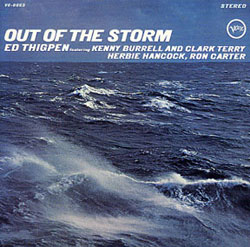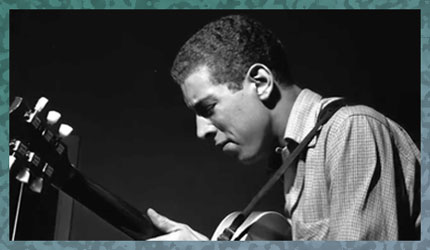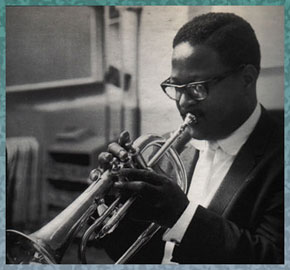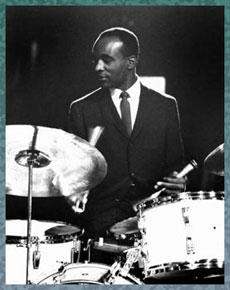

|
Soundclip:
|
| See Steve's Hand-Written Comping
Transcription |
|
Kenny Burrell's comping on: "Cielito Lindo"(Quirino Mendoza y Cortés) Yet again, by an act of complete coincidence, I was transported back to another memory from my college years, those years of discovery, at U.C.L.A. between 1965-69. Many of you reading this today in 2015, might not remember that, in those days, one did their musical research on foot,  and not by accessing information via the internet. By this I mean that music fans, Jazz fans, like me had to spend hours in their local LP store patrolling the album bins and looking for recordings that featured the names of sought after players. It was probably on one such afternoon that I stumbled upon an album from 1966 by drummer Ed Thigpen titled, "OUT OF THE STORM"(Verve), that featured 4 of my favorite players from any time period: Kenny Burrell(Guitar); Ron Carter(Ac. Bass); Herbie Hancock(Piano); and Clark Terry(Trumpet/Flügelhorn). At that moment, I was probably most thrilled to see the name of Kenny Burrell!!! I don't think that I ever expected to find that the traditional Mexican folk song, "Cielito Lindo" would become my favorite tune on the album. Producer Creed Taylor must have sensed something too because he selected this tune to open the album! and not by accessing information via the internet. By this I mean that music fans, Jazz fans, like me had to spend hours in their local LP store patrolling the album bins and looking for recordings that featured the names of sought after players. It was probably on one such afternoon that I stumbled upon an album from 1966 by drummer Ed Thigpen titled, "OUT OF THE STORM"(Verve), that featured 4 of my favorite players from any time period: Kenny Burrell(Guitar); Ron Carter(Ac. Bass); Herbie Hancock(Piano); and Clark Terry(Trumpet/Flügelhorn). At that moment, I was probably most thrilled to see the name of Kenny Burrell!!! I don't think that I ever expected to find that the traditional Mexican folk song, "Cielito Lindo" would become my favorite tune on the album. Producer Creed Taylor must have sensed something too because he selected this tune to open the album!Having grown-up in West Los Angeles, I remember that, as a child, we had to sing, as a group in one of our classes, "Cielito Lindo" and mostly, we were singing some kind of an English translation [which I cannot find a single one anywhere that matches my memories of the lyrics that we sang], and a few phrases in the traditional Spanish. Of course, everyone knows and remembers these lines, especially the first two, which we all learned phonetically, of course: Ay, ay, ay, ay, Canta y no llores, Porque cantando se alegran, cielito lindo, los corazones. Many Jazz fans associate drummer Ed Thigpen with the great Oscar Peterson, as they made some 25 albums together, however, my memories of Ed are forever attached to his arrangement, in 4/4 and played in cut-time, of "Cielito Lindo."  Though the soundclip that appears here is edited, you can hear that it begins with Ed stating the melody on his tom-toms. It was a brilliant and eminently musical idea. As a friend had just written to me about the wonderful documentary on Clark Terry, my memories immediately guided me back to this tune, Clark's wonderfully swingin' performance of the melody, and the incredible bounce to his soloing. As I listened to the complete version, I was struck by how fantastic Kenny Burrell's comping was during the melody section, and that inspired me to quickly jot it out, and then share it here at KORNER 1. Though the soundclip that appears here is edited, you can hear that it begins with Ed stating the melody on his tom-toms. It was a brilliant and eminently musical idea. As a friend had just written to me about the wonderful documentary on Clark Terry, my memories immediately guided me back to this tune, Clark's wonderfully swingin' performance of the melody, and the incredible bounce to his soloing. As I listened to the complete version, I was struck by how fantastic Kenny Burrell's comping was during the melody section, and that inspired me to quickly jot it out, and then share it here at KORNER 1.Obviously, this arrangement has its roots in some area of Latin music, and, of course, it is being performed by a group of wondrous players that includes no Latinos. When great musicians come to live, work and grow in New York, they are all surrounded by the music of multiple cultures on a daily basis, and the influences of all that music going on manages to infiltrate your consciousness and being, even if one is not paying any serious attention to it. Latin music is everywhere here, and I think that any reasonably musical person can't help but develop, or have a sense of what's going on with it. To try and be more certain about the rhythmic details, yet again, I consulted with my dear friend, saxophonist/composer-arranger/author/photographer Rafael Greco to enlist his perceptions about the "feel" and what the clave might be, IF he heard any sense of it within this performance. Rafa and I seemed to be in agreement that, perhaps, the influence of Brazil, with an American swing to it, was actually more present than anything related, in a formal way, to Latin music and the clave. If one sings this classic melody in 4/4, without accompaniment, it seemed to both of us that the clave would have been in 2:3. But the performance doesn't seem to indicate that, although I hear strains of Latin music in what Kenny plays, and with Herbie's approach too, especially the octaves in his right hand. So, hearing the performances of Ron Carter, Herbie Hancock, and Kenny Burrell, you can clearly hear that they have all paid some attention to the unique and brilliant nuances of Latin music. Ron's bass tumbao relies on a fairly consistent pattern per bar of a half-note followed by two quarter-notes on beats 3 & 4. What I love so much about what Kenny plays during the melody statement is that, in creating an approach born of counterlines, he alludes to inner-voice movements that would have been a part of virtually any montuno or guajeo that a more traditional tres or piano player might have come-up with. If we take a look at what Kenny plays during letter [A], those single notes, D-natural to Eb are really the top voice of what could easily make-up the guts of the guide tones for the two basic chords: Bbmaj7[A-D] and F7[A-Eb]. Notice how free and easy Kenny is at adding in his own sense of melody in bars 6-8; 10-12; and 13-16. Perhaps, these counterlines sound so melodic because they are, relative to the key of Bb, completely diatonic in nature. There is not a single chromatic note or blue note anywhere to be found. As [A2] quickly arrives, Kenny's phrasing continues to loosen and, in bar 6, you see the 1st chromatic note, a passing tone, as the line descends from F through E-natural down to Eb. Then, in bars 7-8, Kenny's Jazz sensibilities come right to the fore with a nicely arpeggiated line over the Cm7-F7 change. In bars 9-12,  Kenny picks up on the most subtle part of Clark Terry's melody interpretation, and creates a counterline based upon that idea. Finally, after so much diatonic playing, Kenny's blues roots reveal themselves in the last phrase of bar 16. Kenny picks up on the most subtle part of Clark Terry's melody interpretation, and creates a counterline based upon that idea. Finally, after so much diatonic playing, Kenny's blues roots reveal themselves in the last phrase of bar 16.As letter [B] is the last section of this [A][A2][B] song format, Kenny waits for this moment to finally introduce some full chord voicings, and very much in the traditional Jazz guitar style. The 1st of those chords is in bar 2, a Bb7#5(F# on top) resolving to Ebmaj7(G-natural on top). In bar 6, we have our first altered tone as an F7(13b9) voicing is employed. Once again, in bars 7-8, Kenny's bluesy nature jumps right in to fill that little space. Returning to fuller voicings again for bars 9-11, we now hear, over the G7(alt.) chord, the movement of #9-b9(Bb-Ab) in the top voice. This gives the interpretation some Jazz harmonic hipness in the middle of, what is essentially, a very traditional folk song, moving back and forth between I-V7. It's such a nice touch without ever appearing to be heavy-handed or forced. The edited soundclip takes you through most of Clark Terry's wonderful solo, and you can listen to how Kenny Burrell's comping expands and reverts to his natural Jazz-oriented style. Notice at varying moments how his top voice functions as a long-tone melody while ascending under Clark's solo lines. It's wonderful to hear and, as always, so very musical. Speaking of being "so musical," how can one not marvel at Herbie Hancock's impeccable sense of good taste, as he has virtually laid-out for most of the performance thus far, until gracefully sneaking in during the latter portion of the [B] section of Clark's solo. Perhaps this was a concept that was discussed between the players and the producer? Perhaps it was just something that Herbie decided to do based upon his own good instincts and years of experience. Often times when one is playing harmonically simple tunes like "Cielito Lindo," and you have piano and guitar together, something has to give somewhere, because there is no way that most players have the kind E.S.P. connection that would never betray a conflict over altered note choices, or passing chords, etc.!!! So, in the end, laying out becomes the best possible choice to make. I remember, ages ago, when I was learning how to play, a wiser and older veteran once said to me: "When in doubt, lay out!!!" On Pg. 2 of this brief comping transcription, I have offered my own "guide tones" suggestions for how you might go about shaping another level of comping, especially in a Latin style. In the end, it really depends upon how you vary the rhythms. It is almost like playing a broken chord style, except that you would only be using these two essential notes per chord each time. Depending upon how many choruses are going to be played, the guide tones could provide a very comfortable 1st or 2nd layer, played well before one ever employed full chords. Inspired further, after repeated listening, I decided to transcribe all of Kenny's comping under Clark Terry's solo. A last minute addition, the link to the transcription appears as Pg. 3 on the transcription page link. Unlike the more Latin-influenced counterlines that graced Kenny's playing behind the melody, here you can see that Kenny allows the space to be filled by Ed Thigpen's propulsive drum rhythms, Ron Carter's buoyant bass feel, and, of course, Clark Terry's be-bop oriented line configurations.  There is no great need for a lot chordal activity, and if you explore the transcription, you can see that there is a tremendous amount of space between Burrell's chordal punctuations. In other words, just look at all the rests in each bar. You will also notice and hear that Kenny left the last 4 bars of Clark's solo completely open, as he was no doubt readying himself for his solo that was to come. Sometimes, that open space is the moment to make certain that your volume and tone controls are exactly where you would want them to be. There is no great need for a lot chordal activity, and if you explore the transcription, you can see that there is a tremendous amount of space between Burrell's chordal punctuations. In other words, just look at all the rests in each bar. You will also notice and hear that Kenny left the last 4 bars of Clark's solo completely open, as he was no doubt readying himself for his solo that was to come. Sometimes, that open space is the moment to make certain that your volume and tone controls are exactly where you would want them to be.During the mid-'60s, Verve was making quite a transition, and many would come to feel that it was a transition to a more commercial form of Jazz. Just as many serious fans and critics alike would have found this to be a rather odious trend. Part of the problem for the artist and the label during the LP era was that, in order to have the most level, or volume, on your vinyl, the perfect length for either side of an LP was 18-minutes or less. Any more time than that? You would begin to lose level in degrees. So, a label like Verve began to offer more songs, going from the tradition in Jazz of 6 tunes, 3 per side, on an LP, to 8 total tunes, or even more in some cases. If you divide 4 tunes into 18-minutes, each tune becomes around 4-minutes or less. Add another tune? And it's going to be worse for the hardcore Jazz fan. But with the unexpected successes of artists like organist Jimmy Smith, Wes Montgomery, Cal Tjader and others, Verve was changing its philosophy, and perhaps, those changes actually signaled the beginning of the "Smooth Jazz" Era long before it was even an invented term for a genre! One of the nicest things for me was to actually have Ed Thigpen stop by to say "Hello!" at varying times as my European tours, especially during the '90s, would pass through his newly found home in Copenhagen, Denmark. He was always so warm and friendly, and seemed to enjoy seeing and hearing some compatriots from the USA pass through, and respond to his kindness with great respect and appreciation for all of his own accomplishments. He was a wonderful person, and such a superb musician. I now wish that I had spent a little more time talking about "Cielito Lindo" with him during our private conversations backstage on some lost night in Europe!!! Thanks so much for everything Ed, and now Clark!!! Still with us, I don't think that I will ever tire of listening to Kenny Burrell from around this period in his expansive career.
[Photo of Kenny Burrell by: Francis Wolff 1956
Photo of Clark Terry by: Chuck Stewart 1965 Photo of Ed Thigpen by: Heinz Kronberger ca. 1960] |